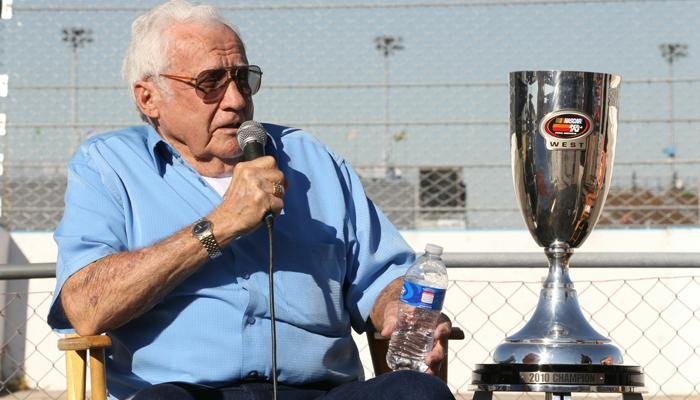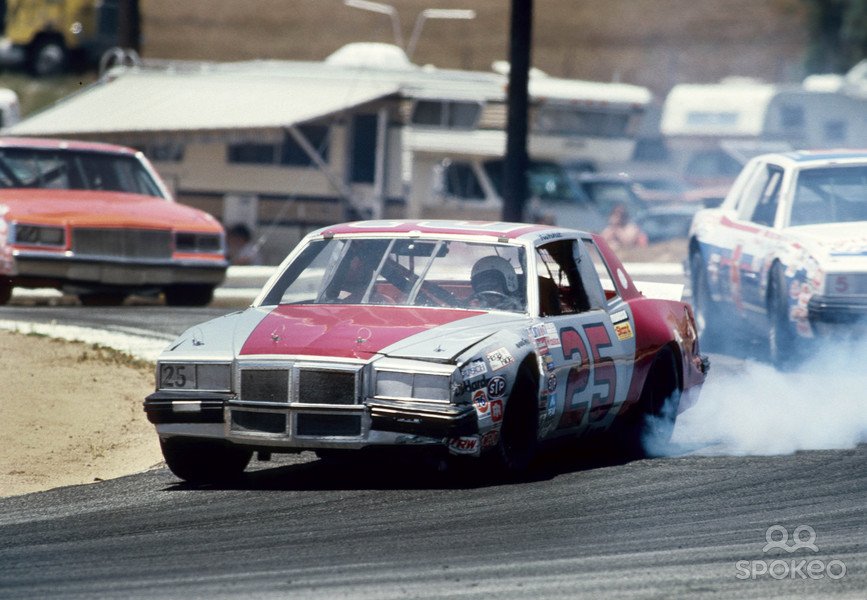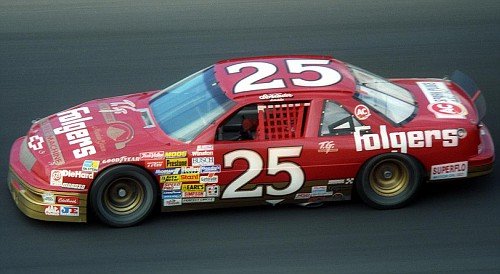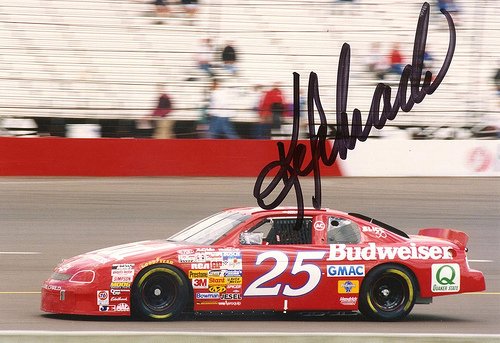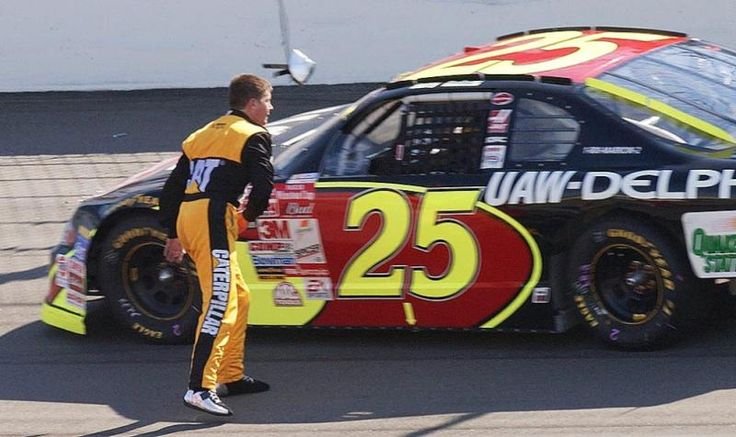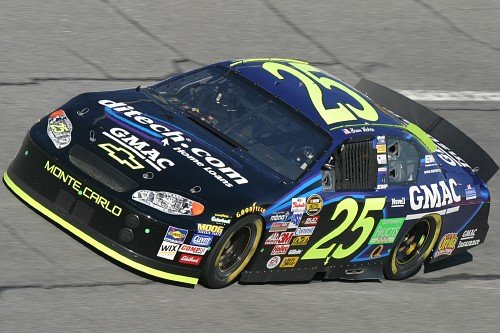
In NASCAR Cup Series competition the #25 car has started 1317 races with 89 drivers and has 21 wins, 38 poles, 123 top 5s, 340 top 10s, and 369 DNFs.
From 1949-1951 Jack White competed in 12 NASCAR Strictly Stock/Grand National (Cup) races including 1 race in #25. The September 18, 1949 was the 5th Cup series race ever held, and Jack earned his only career win in his only start in #25- a 100% victory rate in the number.
Dick Linder drove the #25 in 19 events from 1950-1951 including 3 wins.
Lloyd Dane started 6 races in #25 during the 1956 season and captured 1 of his 4 career wins during that time.
Jabe Thomas was a NASCAR driver from Christianburg, VA. He competed in 322 NASCAR events in his career, 306 of which were in #25, spanning from 1965 to 1978. Thomas was one of the top independent drivers of his time, finishing in the top-ten in points four times, bested by a 6th in the 1971 standings. Overall, Thomas earned a remarkable 77 top-tens in his career, bested by a 4th place at New Asheville.
Ronnie Thomas started 123 of his 197 career races in car #25. He was the 1978 NASCAR Winston Cup Rookie of the Year, edging out Roger Hamby in a race that went down to the wire at the Los Angeles Times 500. Thomas’s father, Jabe Thomas was also a NASCAR driver. In 1980, his best season he finished 14th in the points in #25 Stone’s Cafeteria car. He led a career total of four laps in Winston Cup competition from 1977-1989.
NASCAR Superstar Tim Richmond drove the #25 for 37 races from 1986- 1987 inluding 9 of his 13 career wins. Richmond joined Hendrick Motorsports in 1986, where he teamed up with veteran crew chief Harry Hyde. It took the team until the middle of the season to gel. Richmond had suffered a 64-race winless streak that was finally broken at the Van Scoy Diamond Mine 500 at Pocono in June 1986. After two straight second place finishes at Charlotte and Riverside, Richmond started the Pocono event in third place inside the second row. That race saw a caution for rain with five laps left before the halfway point. NASCAR wanted the cars to get to the halfway point to make the race official, so the sanctioning body had the drivers slowly circle the track. It took the drivers 26 minutes to complete the laps, and the rain was so heavy that some drivers had to look out their side windows because they could not see out their windshields. Two hours later, the track had dried and the race resumed with Richmond in third. After Richmond’s car was adjusted to remove the “push”, the car was more to his liking. Because his radio did not work, he was unable to communicate with his crew chief, Hyde, and he made his final pit stop with 37 laps left. Hyde worried that Richmond had stopped a lap too early to ensure that he would have enough fuel to make it to the end. After Richmond took the lead with 30 laps left in the race, Dale Earnhardt made up three seconds on Richmond’s five-second lead. With four laps to go, Buddy Arrington spun in a three-car accident. The remaining laps of the race where completed slowly under caution and Richmond took the checkered flag for the victory. He had led 97 laps, including the final 30, taking his first victory in a Rick Hendrick car.
The tour returned to Pocono a month later, and Richmond battled for another victory in a fog-shortened event. In the final 8-lap sprint, Richmond competed in a three-car battle with Geoff Bodine and Ricky Rudd. Richmond crossed the finish line beside Rudd, winning the race by 0.05 seconds. He notched four more victories that season, and over a span of twelve races, Richmond earned three second place finishes, and six wins. The National Motorsports Press Association named him Co-Driver of the Year with Earnhardt after Richmond accumulated 13 top 5 finishes and 16 in the top 10. He had a career-best third place finish in points after winning seven events in 1986, in what was his last full NASCAR season.Richmond fell ill the day after the 1986 NASCAR annual banquet during a promotional trip to New York. He was not well enough to begin the 1987 NASCAR season despite lengthy hospitalization in Cleveland and further rest at home; when Richmond missed the Daytona 500, his condition was reported as double pneumonia. Media later reported that he had tested positive for acquired immune deficiency syndrome (AIDS). He returned to Pocono for the Miller High Life 500 during the middle of the year. Starting third, he led by the fifth lap and ultimately led 82 laps, including the final 46, to win the race by eight car-lengths over Bill Elliott. In the middle of the race, Richmond’s car suffered gearbox problems. Because he could use only fourth (high) gear, he had to use that gear to slowly exit the pits. Richmond was emotional after the victory, saying, “I had tears in my eyes when I took the checkered flag. Then every time anyone congratulated me, I started bawling again.” Richmond earned a victory in the next race at Riverside , and made his final 1987 start at Michigan International Speedway’s Champion Spark Plug 400 that August, finishing 29th with a blown engine. He resigned from Hendrick Motorsports in September 1987.
Although Richmond attempted a comeback in 1988, NASCAR suspended him for testing positive for banned substances. The substances were identified as Sudafed, a non-prescription over-the-counter allergy medication, and Advil, an over-the-counter pain reliever. In April 1988, Richmond sued NASCAR over the suspension. Although he retested later that year and was reinstated, he could not find a car to drive. In his final public appearance in February 1988, Richmond denied that he abused drugs and said that a mistake had been made in his drug test.His suit with NASCAR was settled out-of-court, the terms sealed.
Richmond withdrew into his condo in Florida. There were by then rumors of HIV and AIDS, which he denied. He was later hospitalized in West Palm Beach.
ESPN sent a get-well-soon card to Richmond when it aired the July 1989 NASCAR race at Pocono. The television network showed highlights of Richmond’s victory at the track from 1986. “Tim had Hollywood good looks and the charisma of Tom Cruise,” said his friend Dr. Jerry Punch. “There he was in victory lane with the team all around him and beauty queens hanging all over him. It was important for the people at the hospital to see Tim the way he really was, when he was healthy and handsome and vital, not the way he was as they saw him every day in the hospital.”
On August 13, 1989, Richmond died at the age of 34, about two years after his final NASCAR race. He was buried in Ashland, Ohio. The secrecy surrounding the circumstance of his death caused speculation for several days. At the time, Punch stated that Richmond had been hospitalized due to a motorcycle accident, though it is unlikely that Richmond had the strength to ride a motorcycle during his last months. Ten days after his death, on August 23, the Richmond family held a press conference to reveal that Richmond died from complications from AIDS, which he acquired from an unknown woman. Richmond’s physician, Dr. David Dodson, said: “There’s no way of knowing who that woman was. Tim was a celebrity with a lot of charisma, a handsome guy. He naturally attracted a lot of women.” Punch later claimed that more than 90 drivers and personnel underwent HIV testing in the wake of Richmond’s death.
In 1990, a few months after Richmond’s death, Washington television station WJLA-TV and reporter Roberta Baskin reported that Dr. Forest Tennant, who was then the National Football League’s drug adviser, “falsified drug tests” that ultimately helped shorten Richmond’s NASCAR career. Baskin reported that sealed court documents and interviews showed Tennant and NASCAR used “allegedly false drug-test results in 1988 to bar Richmond from racing”. Baskin also stated that NASCAR had targeted Richmond, requesting that Tennant establish a substance-abuse policy with Richmond in mind. A series of drug tests and falsely reported positive results shortly before the 1988 Daytona 500 kept Richmond from driving in what was to have been his last big race…”, the report said. The New York Times published the findings. While neither Tennant nor NASCAR supplied an official response at the time, NASCAR did confirm that they were seeking to replace Tennant.
The Ashland County Sports Hall of Fame inducted Richmond in their second class in 1996. In 1998, NASCAR named Richmond one of its 50 greatest drivers of all time. He was inducted into the International Motorsports Hall of Fame in 2002. The Mansfield Motorsports Park ARCA Re/Max Series race in 2009 was named the Tim Richmond Memorial ARCA Re/Max 250 in honor of the area native.
Richmond’s story of persecution is the story of many individuals who were effected by HIV and AIDS in the 1980s, a time before the world fully understood the disease. The documentary film Tim Richmond: To The Limit was produced as part of ESPN’s 30 for 30 series with a premiere date of October 19, 2010. Cole Trickle, the main character in the movie “Days of Thunder”, played by Tom Cruise, was loosely based on Richmond and his interaction with Harry Hyde and Rick Hendrick.
Ken Schrader drove the #25 car in 267 races for Hendrick Motorsports from 1988-1996 including 4 wins. In his first race, he won the pole for the Daytona 500, beginning a three-year streak in which he won the pole for that race. After failing to qualify for the following race and purchasing a racecar from Buddy Arrington, Schrader won his first career race at the Talladega DieHard 500 , and finished fifth in the final standings. He won his second career Cup race the following season at Charlotte Motor Speedway, and finished fifth in the standings again.
Kodiak became Schrader’s sponsor in 1990. Although he failed to win , he collected three poles, and seven top-fives, dropping to tenth in points. In 1991, he got his third win at the Motorcraft Quality Parts 500, and his final win to date at Dover International Speedway. He had nine total top-five finishes and finished ninth in the final points standings. In 1992, he dropped to seventeenth in the standings after posting eleven top-tens. The following season, Schrader returned to ninth in the points and won a career-high six poles. He had his career-best points finish in 1994, when he finished fourth. He also won his most recent Busch race at Talladega.
In 1995, Budweiser became Schrader’s primary sponsor. He won his final pole with Hendrick at Pocono Raceway and dropped back to seventeenth. He survived a horrifying crash in the DieHard 500 at Talladega Superspeedway. After he improved only to twelfth in the standings in 1996, Schrader left Hendrick Motorsports after a nine-year association with the team.
Ricky Craven raced the Hendrick #25 in 30 starts during 1997 season. Craven finished in the top-five in the first two races of the season. He finished 3rd in the 1997 Daytona 500 behind his teammates Terry Labonte in 2nd and Jeff Gordon in 1st giving Hendrick Motorsports a 1-2-3 sweep of the Daytona 500. While practicing for the inaugural Interstate Batteries 500, Craven crashed hard into the wall. He missed two races due to a concussion suffered from the wreck. Jack Sprague and Todd Bodine substituted for Craven driving one race each. Upon his return, he won the Winston Open and finished a then-career-best 19th in points for 1997. In 1998 the #25 would be renumbered #50 to celebrate the 50th anniversary of NASCAR. After injury issues and poor performance Craven would be replaced by Wally Dallenbach Jr.
Wally Dallenbach Jr. started #25 a total of 34 times in 1999. Wally stepped in to sub for Ricky Craven in the #50 Budweiser Chevrolet for Hendrick Motorsports in 1998. The combination worked out well and Wally signed on to continue to drive the car when it changed back to the #25 Budweiser Chevrolet for 1999. It resulted in his best position in the standings of 18th after his 34 starts in the number. However, Dallenbach left the team to drive for a new team and Budweiser moved over to sponsor Dale Earnhardt, Inc.’s #8 car in 2000 and the team needed to hire a replacement and find a sponsor.
Jerry Nadeau drove #25 for Rick Hendrick in 81 starts from 2000-2002 earning his only career win. Nadeau had a solid first year with Hendrick, finishing twentieth in points and winning the season-ending race at Atlanta . The team returned for 2001 with the United Auto Workers and Delphi Auto Parts as co-sponsors, and Nadeau finished a career high seventeenth in points while nearly repeating his Atlanta victory; Nadeau ran out of gas short of the finish and finished fifth. After eleven races in 2002, Nadeau was let go from the team.
“Front Row” Joe Nemechek drove the Hendrick #25 for 57 races from 2002-2003 for 1 win. After eleven races in 2002, Nadeau was let go from the team and Joe Nemechek, who had lost his ride when Haas-Carter Motorsports folded his team due to the bankruptcy of their sponsor Kmart, was hired to replace him. Nemechek won at Richmond in 2003 but was let go before the end of the season so he could join MB2 Motorsports as the replacement for an injured Nadeau.
Nemechek’s replacement in the #25 was Brian Vickers, who was initially supposed to drive the car beginning in 2004 while racing full-time in the Busch Series in 2003 (where he won the championship). During his 112 starts in #25 from 2004-2006 Vickers earned 1 win. UAW and Delphi did not return as sponsors, so Hendrick replaced them with GMAC Financial (Vickers’ primary sponsor in Busch) and ditech.com. With a third place finish in the rookie points battle, his first season was somewhat of a disappointment. 2004 was a sad year for Vickers and the No. 25 team. “Papa” Joe, long-time owner of the No. 25 car, died in July, while close friend Ricky Hendrick perished in a plane crash that also took the lives of nine others in October. Vickers improved to seventeenth in points in 2005. Midway through the 2006 campaign, Vickers announced he would leave Hendrick Motorsports at the end of the season. On June 9, 2006 Hendrick Motorsports announced that Casey Mears of Chip Ganassi Racing would take the spot of Vickers in 2007. Vickers collected his first career win later that season at Talladega in a controversial finish .
In 2007, the Army National Guard joined forces with longtime Hendrick Motorsports partner GMAC to sponsor the No. 25 Chevrolet driven by Casey Mears. Mears piloted the No. 25 to his first career win at Charlotte Motor Speedway in the Coca-Cola 600 , his only win to date. After the season, Mears moved to the #5, while the fourth full-time ride was given to the new #88 for Dale Earnhardt, Jr., who replaced Kyle Busch at Hendrick Motorsports. This left the #25 as a part-time team. Mears ran 36 races in the #25 in 2007.
In 2015 Chase Elliott drove a fifth entry for Hendrick motorsports in five races in the Cup Series as he prepared to take over the #24 car for the 2016 season.
Other notable names in #25
Brad Keselowski, 9 starts
Fireball Roberst, 5 starts
Bobby Gerhart, 5 starts
Ned Jarrett, 1 start
Buddy Baker, 1 start
Rick Hendrick , 1 start
Mark Martin , 2011 All-Star Race.


